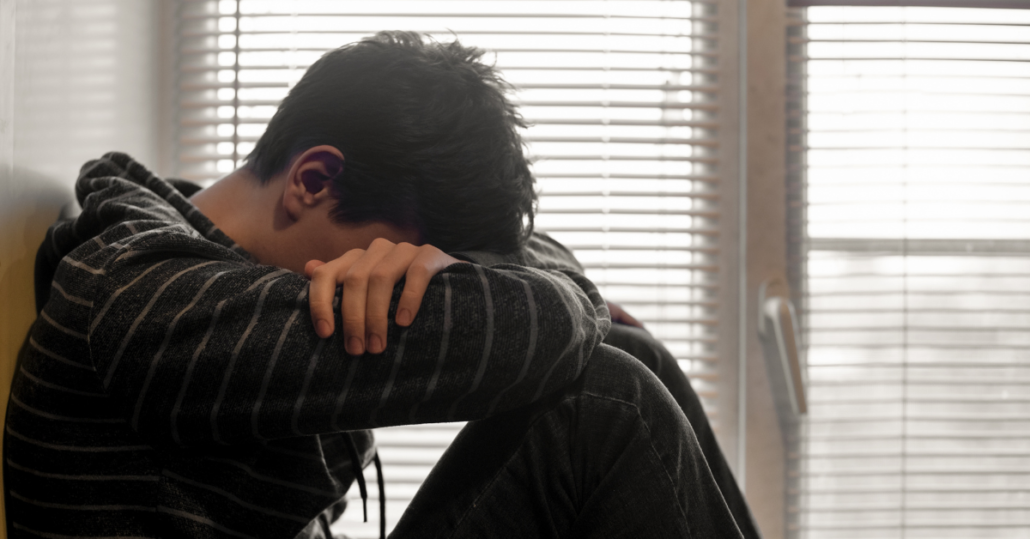Mood Disorder Definition
A mood disorder is a mental health problem that primarily affects a person’s emotional state. It is a disorder in which a person experiences long periods of extreme sadness, happiness, or both. According to the National Institute of Health (NIH) [1], Mood is defined as a sustained and pervasive feeling tone that is endured internally and impacts nearly all aspects of a person’s behavior in the external world.
Mood disorders or affective disorders are marked by emotional disruptions. Severe lows are called depression and extreme are highs called hypomania or mania. The cycling between both depressed and manic moods is characteristic of bipolar mood disorders. If you have a mood disorder, your mood or general emotional state is inconsistent or distorted with your circumstances and interferes with your ability to function.
About 21% of U.S. adults had any mood disorder in the past year. Past year prevalence of any mood disorder among adults was higher for females (11.6%) than for males (7.7%) [2]. Of adults with any mood disorder in the past year, the degree of impairment ranged from mild to serious. An estimated 45.0% had a serious impairment, 40.0% had moderate impairment, and 15.0% had mild impairment.
Mood disorders are treated primarily through psychotherapy and medications. Even with treatment though, it is not uncommon for mood disorders to persist throughout a lifetime or to come and go on occasion. Education about mood disorders help people suffering from these conditions recognize thought and patterns of behavior that are indicative of a mood disorder resurfacing – and warn them to seek additional treatment.


Get Your Life Back
Find Hope & Recovery. Get Safe Comfortable Detox, Addiction Rehab & Mental Health Dual Diagnosis High-Quality Care at the We Level Up Treatment Centers Network.
Hotline (877) 378-4154What Causes Mood Disorders?
Anyone can feel sad or depressed at times. However, mood disorders are more intense and harder to manage than normal feelings of sadness. Children, teens, or adults who have a parent with a mood disorder have a greater chance of also having a mood disorder. However, life events and stress can expose or worsen feelings of sadness or depression. This makes the feelings harder to manage.
Sometimes, life’s problems can trigger depression. Being fired from a job, getting divorced, losing a loved one, death in the family, and financial trouble, to name a few, all can be difficult, and coping with the pressure may be troublesome. These life events and stress can bring on feelings of sadness or depression or make a mood disorder harder to manage.
The risk of depression disorder in women is nearly twice as high as it is for men. Once a person in the family has this diagnosis, their brothers, sisters, or children have a higher chance of the same diagnosis. In addition, relatives of people with a depressive disorder are also at increased risk for bipolar disorder.
Who is at Risk for Mood Disorders?
There may be several underlying factors, depending on the type of the disorder. Various genetic, biological, environmental, and other factors have been associated with mood disorders.
Risk factors include:
- Family history
- Previous diagnosis of a mood disorder
- Trauma, stress or major life changes in the case of depression
- Physical illness or use of certain medications. Depression has been linked to major diseases such as cancer, diabetes, Parkinson’s disease and heart disease.
- Brain structure and function in the case of bipolar disorder
List of Mood Disorders
It is not uncommon for individuals to inaccurately use the terms mood disorder and personality disorder interchangeably. Mood disorders are related to an individual’s relationship with their emotions. Everyone has emotional highs and lows. But for most individuals, they’re manageable and short-lived. Mood disorders cause emotional lows or highs that last for days, weeks, or longer. They’re also more intense than normal.
Personality disorders are patterns of thought, belief, and behavior that differ from the norm. This includes how they form and maintain relationships with friends, family, and intimate partners. Individuals with these personality disorders tend to repeat patterns in their relationships, which are often confusing, volatile, and difficult. The primary difference between the two is that mood disorders generally cause periods of emotional highs and/ or lows.
Two of the most common mood disorders are depression and bipolar disorder.
Depression (major or clinical depression). Depression disorder is a common mental disorder. Grief or sadness is a typical response to a traumatic life event or crisis, such as the death of a spouse or family member, loss of a job, or a major illness. However, when the depression continues to be present even when stressful events are over or there is no apparent cause, physicians would then classify the depression as clinical or major depression. For a person to be diagnosed with clinical depression, symptoms must last for at least two weeks.
There are several different types of depression. Symptoms may vary depending on the form of the disorder.
- Postpartum depression (peripartum depression) – This type of depression happens during pregnancy or after delivery
- Persistent depressive disorder (dysthymia) – This is a chronic form of depression that can last for at least two years. Symptoms may occasionally lessen in severity during this time.
- Seasonal affective disorder (SAD) – This is another type of depression that happens during certain seasons of the year. It usually begins in the late autumn or early winter and lasts until spring or summer. Less commonly, SAD episodes may also start during the late spring or summer. Symptoms of winter seasonal affective disorder may resemble those of a major depression. They tend to disappear or lessen during spring and summer.
- Psychotic depression – This is a type of severe depression combined with psychotic episodes, such as hallucinations (hearing or seeing things that others do not) or delusions (having fixed but false beliefs). The episodes may be disturbing or upsetting and often have a theme.
- Depression related to a medical condition, medication, or substance abuse
Get Help. Get Better. Get Your Life Back.
Searching for Accredited Drug & Alcohol Rehab Centers Near You? Or Mental Health Support?
Even if you have failed previously, relapsed, or are in a difficult crisis, we stand ready to support you. Our trusted behavioral health specialists will not give up on you. Call us when you feel ready or want someone to speak to about therapy alternatives to change your life. Even if we cannot assist you, we will lead you wherever you can get support. There is no obligation. Call our hotline today.
FREE Addiction Hotline – Call 24/7Bipolar disorder (manic-depressive disorder). Bipolar disorder is defined by swings in mood from periods of depression to mania. When a person experiences a low mood, symptoms may resemble those of clinical depression. Depressive episodes alternate with manic episodes or mania. During a manic episode, a person may feel euphoric or can also feel irritable or have increased levels of activity.

There are four basic types of bipolar disorder.
- Bipolar I – This is the most severe form. Manic episodes last at least seven days or may be severe enough to require hospitalization. Depressive episodes will also occur, often lasting for at least two weeks. Sometimes symptoms of both mania and depression are present at the same time.
- Bipolar II disorder – This disorder causes cycles of depression similar to those of bipolar I. A person with this illness also experiences hypomania, which is a less severe form of mania. Hypomanic periods are not as intense or disruptive as manic episodes. Someone with bipolar II disorder is usually able to handle daily responsibilities and does not require hospitalization.
- Cyclothymia disorder (cyclothymia) – This type of bipolar disorder has sometimes been defined as a milder form of bipolar disorder. People with cyclothymia experience continuous irregular mood swings – from mild to moderate emotional “highs” to mild to moderate “lows” – for extended periods of time. In addition, changes in mood can occur quickly and at any time. There are only short periods of normal mood. For an adult to be diagnosed with cyclothymic, symptoms have to be experienced for at least 2 years.
- “Other” or “unspecified” bipolar disorder – Symptoms of this type of bipolar disorder do not meet the criteria for one of the other types but people still have significant, abnormal changes in mood.
Other Mood Disorders
- Premenstrual dysphoric disorder – This type of mood disorder occurs seven to 10 days before menstruation and goes away within a few days of the start of the menstrual period. Researchers believe this disorder is brought about by the hormonal changes related to the menstrual cycle. Symptoms may include anger, irritability, tension, decreased interest in usual activities, and sleep problems.
- Intermittent explosive disorder – This is a lesser-known mood disorder marked by episodes of unwarranted anger. It is commonly referred to as “flying into a rage for no reason.” In an individual with intermittent explosive disorder, the behavioral outbursts are out of proportion to the situation.
Comfortable Facilities & Amenities
High-Quality Addiction & Mental Health Rehabilitation Treatment
Rehab Centers TourRenowned Addiction Centers. Serene Private Facilities. Inpatient rehab programs vary.
Addiction Helpline (877) 378-4154Proven recovery success experience, backed by a Team w/ History of:
15+
Years of Unified Experience
100s
5-Star Reviews Across Our Centers
10K
Recovery Success Stories Across Our Network
- Low Patient to Therapist Ratio
- Onsite Medical Detox Center
- Comprehensive Dual-Diagnosis Treatment
- Complimentary Family & Alumni Programs
- Coaching, Recovery & Personal Development Events
Mood Disorder Symptoms
Symptoms depend on the type of mood disorder that is present.
Symptoms of major depression may include:
- Feeling sad most of the time or nearly every day
- Lack of energy or feeling sluggish
- Feeling worthless or hopeless
- Loss of appetite or overeating
- Gaining weight or losing weight
- Loss of interest in activities that formerly brought enjoyment
- Sleeping too much or not enough
- Frequent thoughts about death or suicide
- Difficulty concentrating or focusing
Symptoms of bipolar disorder may include both depression and mania.
Symptoms of hypomanic or manic episodes include:
- Feeling extremely energized or elated
- Rapid speech or movement
- Agitation, restlessness, or irritability
- Risk-taking behavior, such as spending too much money or driving recklessly
- Unusual increase in activity or trying to do too many things at once
- Racing thoughts
- Insomnia or trouble sleeping
- Feeling jumpy or on edge for no apparent reason
How are Mood Disorders Diagnosed?
Major depressive disorder is diagnosed by the presence of five out of the nine symptoms of sad mood, insomnia, decreased energy levels, feelings of guilt, decreased concentration, decrease in pleasurable activities (anhedonia), decreased appetite, increased or decreased psychomotor activity, and recurrent suicidal ideation/acts of self-harm/suicide attempt existing over a period of 2 weeks.
Three new depressive disorders have been incorporated under mood disorders in DSM-5:
- Disruptive mood dysregulation disorder (DMDD) is seen in children and adolescents with frequent anger outbursts and irritability out of proportion to the situation
- Persistent depressive disorder (PDD) or dysthymia, which means a depressed mood that is not severe enough to meet the criteria for major depression. PDD is defined as the depressed mood for at least two years in adults and one year in children and adolescents
- The premenstrual dysphoric disorder (PMDD) is characterized by irritability, anxiety, depression, and emotional lability occurring in a week before the onset of menses followed by resolution of the symptoms after onset.
Major depression episodes may precede or occur concurrently with persistent depressive disorder, and this is known as double depression. Other depressive disorders include depressive disorder due to another medical condition, substance or medication-induced depressive disorder, other specified depressive disorder, and unspecified depressive disorder.
If you’re concerned that you may have a mood disorder, make an appointment to see your doctor or a mental health professional as soon as you can. If you’re reluctant to seek treatment, talk to a friend or loved one, a faith leader, or someone else you trust. Your mood disorder is unlikely to simply go away on its own, and it may get worse over time. Seek professional help before your mood disorder becomes severe — it may be easier to treat early on.
World-class, Accredited, 5-Star Reviewed, Effective Addiction & Mental Health Programs. Complete Behavioral Health Inpatient Rehab, Detox plus Co-occuring Disorders Therapy.
CALL (877) 378-4154End the Addiction Pain. End the Emotional Rollercoaster. Get Your Life Back. Start Drug, Alcohol & Dual Diagnosis Mental Health Treatment Now. Get Free No-obligation Guidance by Substance Abuse Specialists Who Understand Addiction & Mental Health Recovery & Know How to Help.
Alcohol, Substance Abuse and Depression
Alcoholism and other forms of substance abuse are also connected to depression. Dual diagnosis – substance abuse and another mental disorder, usually a mood disorder – is an increasingly serious psychiatric concern. Whether alcohol or drug abuse causes depression, depression leads to drug or alcohol abuse, or both have a common cause, a vicious cycle ensues when addicts use the drugs or alcohol to relieve symptoms the drugs or alcohol have caused.
Cocaine, meth, and other stimulants act on neurotransmitters in the brain’s reward center, causing euphoria that is followed by depression as the effect subsides. Sometimes what appears to be major depression clears up after abstinence from drugs or alcohol. Individuals with severe mood disorders also have twice the average rate of nicotine addiction, and many become depressed when they try to stop smoking.
Dual Diagnosis Treatment
To provide proper treatment for dual diagnosis or co-occurring disorders, the Substance Abuse and Mental Health Services Administration (SAMHSA) recommends an integrated treatment approach. Integrated treatment involves coordinating mental health and substance abuse interventions rather than treating each disorder separately without consideration for the other.
Integrated or dual diagnosis treatment often involves forms of behavioral treatment, such as cognitive-behavioral therapy (CBT) or dialectical behavior therapy (DBT), that can help improve coping skills and reduce maladaptive behaviors. These may be used in combination with medication-assisted treatment (MAT). Integration is key to achieving a healthy balance and long-term recovery.
Treating co-occurring disorders is a critical aspect of our inpatient treatment experience because co-occurring disorders are strongly connected with instances of substance abuse. Creating a treatment plan that addresses the physical aspects of withdrawal, the psychological connection with drug use, and addressing underlying mental health disorders is all a part of setting clients up for success.
At We Level Up NJ, we believe that if the client can identify the underlying mental health issue and treat it simultaneously with their treatment for substance abuse, the client’s chances of a successful, relapse-free recovery are much improved. In fact, once we can identify and properly begin treatment on the underlying issues such as mood disorders that are driving or co-occurring with the dependency on alcohol or other drugs, clients will have reached a major milestone and will be that much closer to long-term sobriety.

Experience Transformative Recovery at the We Level Up Treatment Center.
See our authentic success stories. Get inspired. Get the help you deserve.



Start a New Life
Begin with a free call to an addiction & behavioral health treatment advisor. Learn more about our dual-diagnosis programs. The We Level Up treatment center network delivers various recovery programs at each treatment facility. Call to learn more.
- Personalized Care
- Caring Accountable Staff
- Comfortable Amenities
- Licensed & Accredited
- Renowned w/ 5-Star Reviews